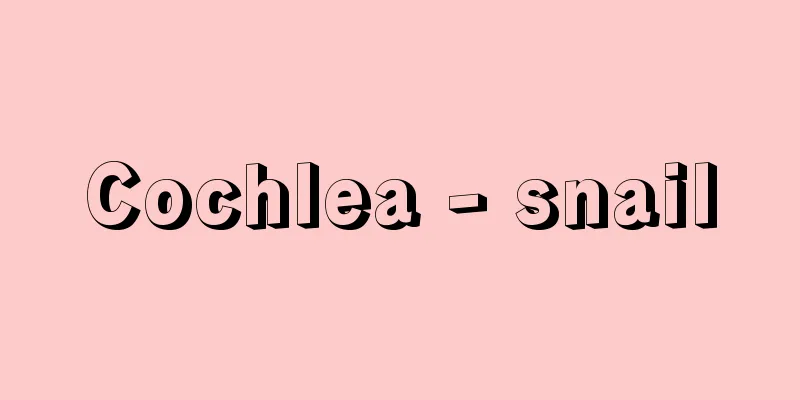Cochlea - snail

〘Noun〙 (A variation of "katatsuburi") A general term for large land snails belonging to the mollusks and pulmonates. It may also include land-dwelling species such as the Yamatanisi, a prosobranch. Most have right-handed shells. They move by sticking their heads and parts of their bodies out of the shell, but retract them into the shell when they are dry or startled. They have two pairs of antennae on their heads, and at the tip of the longer pair are eyes that can distinguish between light and dark. The shorter pair are said to be organs that sense chemical substances. The surface of their soft bodies is covered with mucus. They breathe through a mantle cavity, where blood vessels are gathered in a network that acts as lungs. They have a file-like radula in their mouth, which they use to lick and eat mainly dead grass and leaves, sometimes damaging crops. They are hermaphrodites, and lay eggs in the soil. In addition to the commonly seen Onajimamai, there are about 600 known species in Japan, including the Kuroiwamai and Usukawamai. Dendenmushi. A snail. A snail. A prancing ...SnailDede-mushi [snail]SnailsDen-den-demushi [snail]SnailDen-den-mushi [snail]Snail (cochlea)Source: The Selected Edition of the Japanese Language Dictionary About the Selected Edition of the Japanese Language Dictionary Information |
〘名〙 (「かたつぶり」の変化した語) 軟体動物、有肺類に属する大形陸貝の総称。前鰓類のヤマタニシなど陸産の種を含めることもある。殻は右巻きのものが多い。頭や胴体の一部を殻の外に出して移動するが、乾燥時や驚いた時は殻の中にひっこめる。頭に二対の触角があり、長い方の一対の先端に明暗を識別できる目がある。短い方の一対は、化学物質を感じる器官といわれている。柔らかい体の表面は粘液でおおわれる。血管が網状に集まって肺の働きをする外套腔(がいとうこう)で呼吸する。口にはやすり状になった歯舌があり、これで主に枯死した草や木の葉などをなめるようにして食べ、農作物に害を与えることもある。雌雄同体で、土中に卵を産む。ふつうにみられるオナジマイマイのほか、クロイワマイマイ、ウスカワマイマイなど日本では約六〇〇種ほど知られている。でんでんむし。かたつぶり。かいつむり。まいまい。まいまいつぶろ。まいまいつぶり。かぎゅう。ででむし。《季・夏》※天理本狂言・蝸牛(室町末‐近世初)「かたつむりを用れは其ままよひと申程に、せがれをよび出しかたつふりを取にやらうと云てよひ出す」
か‐ぎゅう クヮギウ【蝸牛】でで‐むし【蝸牛】かた‐つぶり【蝸牛】でんでん‐でむし【蝸牛】かた‐つび【蝸牛】でんでん‐むし【蝸牛】かい‐つむり【蝸牛】出典 精選版 日本国語大辞典精選版 日本国語大辞典について 情報 |
<<: Supercharger - Supercharger (English spelling)
Recommend
Self-cultivation - Jisaku no Ushugi
The idea that the most desirable form of agricultu...
Ramiro de Maeztu
Spanish writer and critic. Born into a wealthy fa...
Sockeye salmon - Sockeye salmon
A fish of the Salmonidae family (illustration). It...
Circular hill - Enkyu
A circular platform on which the emperor worships ...
Tutuila [island] - Tutuila
The main island of American Samoa in the South Pac...
Gasho
...There are dongxiao of various lengths, but unl...
Sex Pistols
… [From punk to new wave] It was poor boys who vo...
Leo (Leo)
The abbreviation is Leo. It is a major spring cons...
Museum of Fine Arts, Boston
Boston is one of the largest art museums in the U...
Ball joint - Kyuukansetu
…In a synovial joint, the protruding joint surfac...
Esso [company] - Esso
…Headquarters: Irving, Texas. Known by its tradem...
Crebillon Father and Son - Crebillon Fushi
Prosper Jolyot de Crébillon (1674-1762) was a Fren...
Mortarboard - Kakubo
A cap worn by university students, with a flat, s...
Red star disease fungus - Red star disease fungus
...The most widely used type of Japanese cedar is...
Horaikyoku - Horaikyoku
Kitamura Tokoku's second collection of poems. ...









